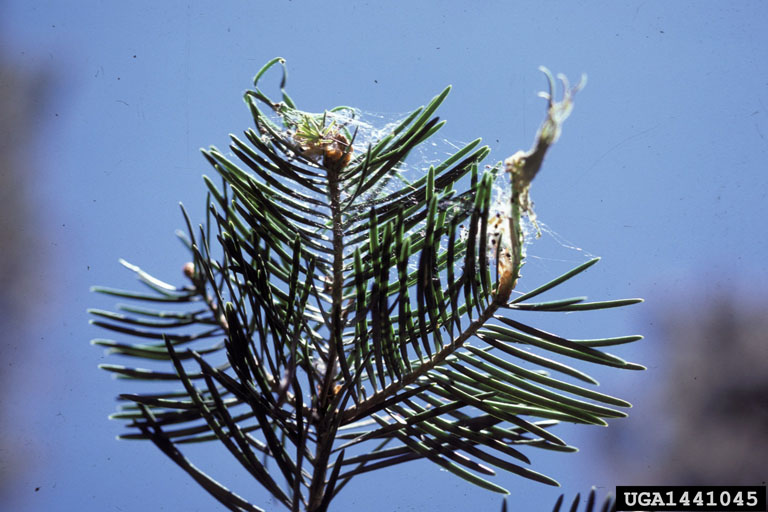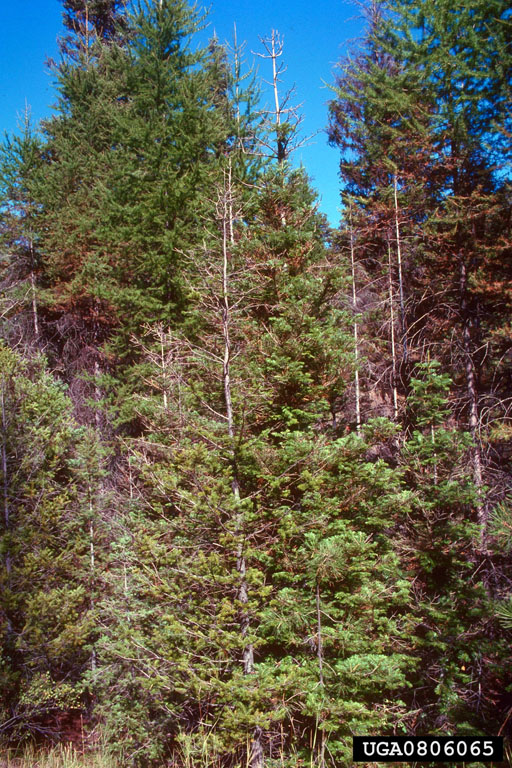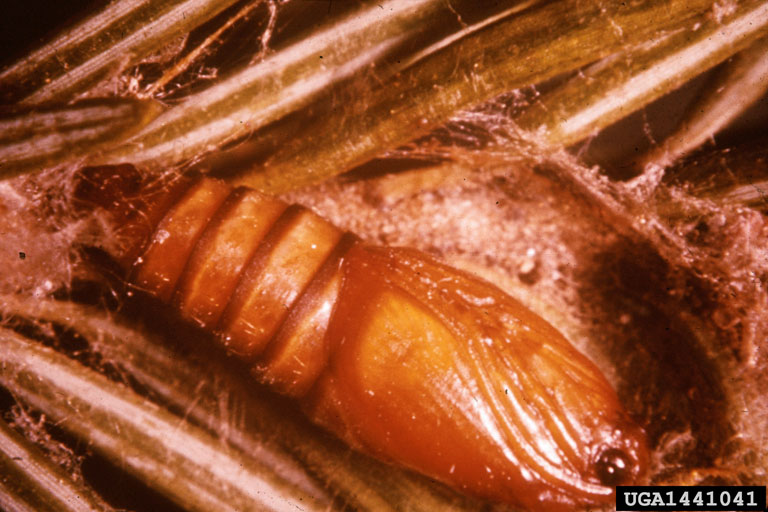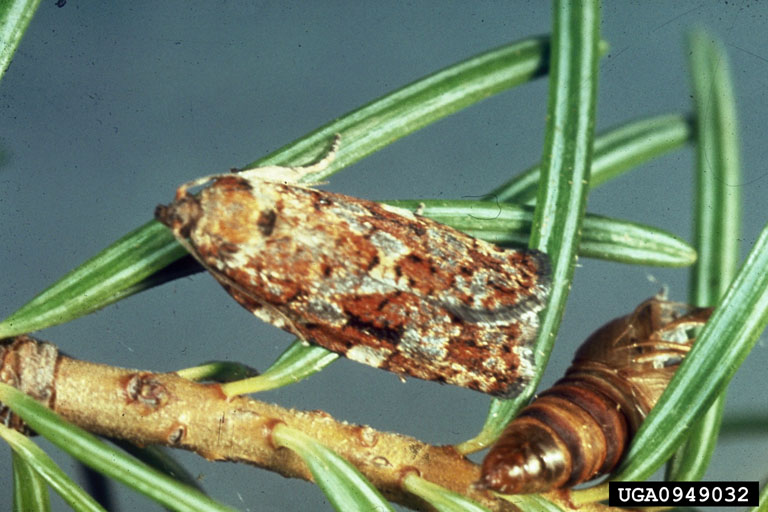Western Spruce Budworm
Choristoneura freemani
Key Wildlife Value:
The western spruce budworm contributes to the creation of snags and down wood by severely defoliating true fir and Douglas-fir trees and interacting with other disturbance agents to cause the death of all sizes of host trees. By causing topkill in all sizes of trees, C. freemani contributes to the formation of unique limb structures and facilitates the colonization of living tree boles by stem decay fungi. During outbreaks, high numbers of larvae, pupae, and moths provide abundant forage for many species of birds, bats, rodents, and invertebrates. Some of the mortality associated with western spruce budworm defoliation contributes to the formation of canopy gaps, increasing structural diversity.
Distribution in Oregon and Washington:
Found throughout both states. (See also Important Habitats and Outbreak Dynamics).
Hosts:
Primarily grand fir, white fir, and Douglas-fir, but also other true firs, Engelmann spruce and western larch. During outbreaks, larvae also may feed on understory non-host tree species, such as pines or hemlocks.
Diagnosis:
During the summer, current year foliage on host trees is chewed and webbed-together, often containing hairless tan caterpillars (larvae).


Larvae or pupae may be found in expanding buds and foliage on branch tips during late May through July.



Life History:
Western spruce budworm has one generation per year. There are four life stages: egg, larva, pupa, and adult. Larvae pass through six developmental stages, called instars, and adults are small moths. Adult females deposit about 150 eggs in masses ranging from a few to over a hundred on the undersides of host tree needles in late summer. Eggs hatch in about 10 days. After hatching, first instar larvae do not feed, but move about searching for sheltered places under bark scales and lichens on the tree bole and limbs to spend the winter. They spin tiny shelters, called hibernacula, then molt and pass the winter in the second instar. In early spring, larvae emerge from the hibernacula and mine old needles, and then tunnel into buds as they begin to swell. They feed on the expanding foliage, constructing silken webbed shelters among the needles that contain partially chewed needles and frass. They also feed on flowers and developing cones, and may sever the shoots of western larch. When disturbed, they wiggle violently and drop from their shelters on silken threads. Those landing on host foliage continue developing, while those that land on non-host foliage or the forest floor usually do not survive. Larvae mature usually in early July 30 to 40 days after leaving their overwintering sites. Pupation takes place during mid- to late July in or near the larval shelters, usually lasting about 10 days. Following emergence, female moths usually remain for a few days in the vicinity of their pupal cases, mating (using pheromones to attract males) and depositing about one half of their eggs before flying away to deposit their remaining eggs elsewhere. Adults usually live about 10 days.
Important Habitats and Outbreak Dynamics:
Most western spruce budworm outbreaks occur east of the Cascade Mountains crest in mixed conifer stands. Large, contiguous expanses of dense, multilayered forests dominated by white or grand firs and Douglas-fir provide ideal habitat for this insect, especially when forests are growing in areas that historically were dominated by fire-climax pine stands. Outbreaks occur sporadically, and appear associated with as-yet-undefined interactions between climatic trends and host abundance and quality. Western spruce budworm populations are always present at very low levels between outbreaks. Parasites and predators such as birds, ants, and small mammals help to regulate budworm populations when they are at low levels, but do not prevent or reduce population increases when forest stand and climatic conditions are favorable. When favorable conditions exist, budworm populations can increase rapidly, appearing to rise nearly simultaneously over relatively large areas, with moth dispersal playing a contributing, though not causal, role.
Budworm dispersal occurs vertically within trees and canopy layers when larvae drop from their feeding sites in response to disturbance. This “showering” effect typically causes understory, intermediate and suppressed trees to be more heavily defoliated and frequently killed than trees in the upper canopy layers, and also results in considerable larval mortality in single-storied stands. Dispersal over longer distances occurs during moth flight, which begins daily just before dusk and lasts until nightfall. The dynamics of moth dispersal are poorly understood. Mapped spread of defoliated areas sometimes occurs in the opposite direction of prevailing winds. Most dispersal is thought to be limited to within a few miles of origin, but documented instances of moth movement over much longer distances indicate that dispersing moths may sometimes be moved about by storm cells or evening winds.
Typically occurring for many years over extensive areas, budworm outbreaks influence stand structure by causing varying levels of decreased tree growth, tree deformity, top kill, and host tree mortality across the landscape. In general, dominant and co-dominant trees suffer less mortality than those that are intermediate or suppressed. Tree mortality usually begins to occur only after four to five or more consecutive years of heavy defoliation. Defoliation commonly interacts with other disturbance agents present in host stands, especially Douglas-fir beetle, fir engraver, and root diseases (particularly armillaria root disease and black stain root disease), to cause more severe effects than might be caused by defoliation alone. Tree density and cover may be significantly reduced in heavily defoliated stands. Effects following outbreaks may range from minor amounts of topkill and understory mortality to patches of 100 percent mortality up to 4 ha in size.
Budworm defoliation can move multistoried forests towards a more single storied condition, due to disproportional effects upon understory trees. By recycling foliage nutrients to the forest floor while suppressing the growth of host trees, defoliation caused by western spruce budworm favors increased growth of intermixed non-host trees relative to host trees for a short period of time. The direct effects of budworm outbreaks rarely significantly alter the long-term trajectory of stand development by altering species composition, because the establishment requirements of shade intolerant tree species are not met in most defoliated stands while at the same time a sufficient number of large, shade-tolerant, host overstory trees survive, thus stands remain dominated by shade tolerant host species. Openings created by budworm defoliation do not appear to regenerate to shade intolerant species either, rather, grasses and forbs and the small surviving seedlings of shade-tolerant species quickly occupy them. Unless wildfire or human intervention occurs, most stands go through a period of recovery and eventually return to a budworm-susceptible condition.
Budworm defoliation may have variable effects upon wildfire hazard and behavior at different scales. There is model-based evidence indicating that heavy defoliation can cause multi-storied mixed conifer stands having overstory components of large, fire-resistant trees such as Douglas-fir, ponderosa pine, and western larch, and understories of true fir to shift toward a single-storied, more fire-resistant condition for several decades (Hummel and Agee 2003). Contrary to common assumptions, western spruce budworm outbreaks do not appear to increase landscape-level risks associated with wildfire (Flower et al. 2014, Meigs et al. 2015, 2016), but may contribute to finer-scale risk of high-severity ground fire.
Generally speaking, stands likely to experience budworm outbreaks are dominated by a mixture of mature grand or white fir and Douglas-fir, have multiple canopy layers, close tree spacing, and occur in a larger matrix of stands having similar characteristics. Within this matrix, those stands most likely to experience significant changes in density, gap frequency, and vertical structure following a prolonged budworm outbreak occur on drier grand or white fir plant associations (that under natural fire regimes were dominated by ponderosa pine), and have a high occurrence of root disease. Other interacting agents, particularly bark beetles, may also cause significant effects in defoliated stands having other characteristics.
Opportunities for Manipulation to Increase Wildlife Habitat:
There is little opportunity for manipulation of western spruce budworm to increase wildlife habitat.
Potential Adverse Effects:
Western spruce budworm outbreaks may result in significant modification of susceptible stands by reducing tree density and cover. Losses of existing cover may degrade the quality of habitat available for some wildlife species such as the northern spotted owl, and associated fuel accumulations may increase the risk of catastrophic wildfire. Reduced growth, topkill, mortality, and altered wood moisture characteristics cause economic losses in wood production areas. Seed orchards and the food supplies of cone and seed feeding wildlife may be negatively affected for many years by significant reductions in cone and seed production. Budworm-associated topkill and mortality also may cause detrimental effects to aesthetic values and public safety in recreational areas.
How to Minimize the Risk of Adverse Effects:
Decreasing the abundance, continuity, and quality of favorable budworm habitat can minimize risk of adverse effects from western spruce budworm outbreaks. This may be achieved by encouraging a greater diversity of stand compositions, densities, canopy structures and age classes across susceptible landscapes. Where appropriate, non-host species should be favored during regeneration, thinning, and selective harvests. Stands having less than 30 percent true firs and Douglas-fir have low susceptibility to western spruce budworm outbreaks. Although thinning does not prevent defoliation, the promotion of vigorous growth by thinning susceptible stands may help to reduce the quality of budworm habitat while enhancing the ability of trees to better withstand the effects of defoliation. In multistoried stands, thinning cuts should be made “from below”, removing intermediate and suppressed trees while leaving co-dominant and dominant trees having high crown ratios. However, thinning can be detrimental if conducted during an outbreak in dense single-storied host stands where trees with crown ratios of less than 30 percent are left, because of the combined deleterious effects of “thinning shock” and budworm defoliation.
Bacillus thuringiensis var. kurstaki (Btk) is a microbial insecticide specific to lepidopterous larvae that is registered for use against the western spruce budworm. It may be used to suppress budworm populations and minimize foliage loss on the areas where it is applied, having short-term effects generally lasting one to two years. Btk applications are not effective for halting or altering the course of budworm outbreaks. Btk is most appropriately applied to well defined, high-value areas, giving careful consideration to minimize non-target effects. More than one application may be necessary to protect selected areas throughout the duration of a prolonged outbreak.
References
Brookes, M.H., R.W. Campbell, J.J. Colbert, R.G. Mitchell, and R.W. Stark, tech. cords. 1987. Western spruce budworm. US Dept. of Ag., Washington, D.C. Tech. Bull. 1694. 198 pp.
Brookes, M.H., J.J. Colbert, R.G. Mitchell, and R.W. Stark, tech. cords. 1985. Managing trees and stands susceptible to western spruce budworm. US Dept. of Ag., Washington, D.C. Tech. Bull. 1695. 111 pp.
Carson, C.E., and Wulf, N.W. 1989. Silvicultural strategies to reduce stand and forest susceptibility to the western spruce budworm. USDA Forest Service, Cooperative State Research Service, Washington, D.C. Ag. Hndbk. 676. 31 pp.
Fellin, D.G. 1985. Dispersal of western spruce budworm larvae and adults as related to silvicultural treatments. In Recent Advances in Budworms Research. Proc. CANUSA Spruce Budworms Research Symposium, C.J. Sanders et al. (eds.) Minister of Supply and Services Canada. p. 116-117.
Fellin, D.G., and J.E. Dewey. 1986. Western spruce budworm. USDA Forest Service, Washington, D.C. Forest Insect and Disease Leaflet 53 (revised). 10 pp.
Flower A., D.G. Gavin, E.K. Heyerdahl, R.A. Parsons, and G.M. Cohn. 2014. Western spruce budworm outbreaks did not increase fire risk over the last three centuries: a dendrochronological analysis of inter-disturbance synergism PloS One 9(12): e114282.
Goheen, E.M. and E.A. Willhite. 2006. Field guide to common diseases and insect pests of Oregon and Washington conifers. USDA Forest Service, Pacific Northwest Region, Portland, OR. R6-NR-FID-PR-01-06. 335 pp. http://www.biodiversitylibrary.org/bibliography/80321#/summary
Hummel, S., and J. K. Agee. 2003. Western spruce budworm defoliation effects on forest structure and potential fire behavior. Northwest Science 77:159–169.
Mason, R.R. and H.G. Paul. 1996. Case history of population change in a Bacillus thuringiensis-treated vs. untreated outbreak of the western spruce budworm. USDA Forest Service, Pacific Northwest Res. Station, Portland, OR. Research Note PNW-RN-521. 11 pp.
Meigs, G.W, J.L. Campbell, H.S.J. Zald, J.D. Bailey, D.C. Shaw, and R.E. Kennedy. 2015. Does wildfire likelihood increase following insect outbreaks in conifer forests? Ecosphere 6(7):118.
Meigs, G.W., H.S.J. Zald, J.L. Campbell, W.S. Keeton, and R.E. Kennedy. 2016. Do Insect Outbreaks Reduce the Severity of Subsequent Forest Fires? Environmental Research Letters 11(4):45008.
Sheehan, K.A. 1996. Effects of insecticide treatments on subsequent defoliation by western spruce budworm in Oregon and Washington: 1982-92. USDA Forest Service, Pacific Northwest Research Station, Portland, OR. Gen. Tech. Rep. PNW-GTR-3667. 55 pp.
Swetnam, T.W. B.E. Wickman, H.G. Paul, and C.H. Baisan. 1995. Historical patterns of western spruce budworm and Douglas-fir tussock moth outbreaks in the Northern Blue Mountains, Oregon since A.D. 1700. USDA Forest Service, Pacific Northwest Res. Sta., Portland, OR. Research Paper PNW-RP-484. 27 pp.
Stevens, R.E., Carolin, V.M., and Markin, G. P. 1984. Lepidoptera associated with western spruce budworm. USDA Forest Service, Cooperative State Research Service, Washington, D.C. Ag. Hndbk 622. 63 pp.
Torgersen, T.R., D.C. Powell, K.P. Hosman, and F.H. Schmidt. 1995. No long-term impact of carbaryl treatment on western spruce budworm populations and host trees in the Malheur National Forest, Oregon. Forest Science. 41(4):851-863.
Wickman, B.E., R.R. Mason, and H.G. Paul, 1992. Thinning and nitrogen fertilization in a grand fir stand infested with western spruce budworm. Part II: Tree growth response. For. Sci. 38(2):252-264.